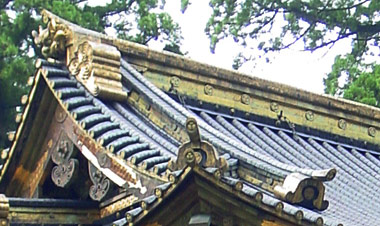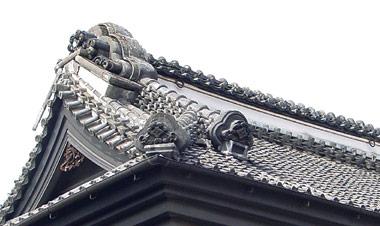|
||
 |
||
1@The classic type, believed to have developed in the early modern period, was used in temples and shrines as a lightweight alternative to the heavy traditional ridge built up entirely from layers of tile. Typically, a row of struts hakomuneuke ó were set upon the ridge purlin munageta (see *oomune å) of the main roof to support the ridge member, called ukemune ¿. A frame was erected around the struts to support the vertical siding, hara-ita Â, the base of which rested upon boards *aori-ita áDÂ laid along the main roof. The roof of the hakomune was formed by a pair of sloping boards, the amenoshi Jàl, spanning from the ukemune to the hara-ita, and the joint between them was protected by a cover piece called the ganburi åU. The hakomune was either cased in copper (especially when the remainder of the roof was made of copper as in many of the structures at Nikkou Toushouguu úõÆ{, Tochigi prefecture) or roofed with tile, the hara-ita being finished with plaster *shikkui ½ò, in the latter case. At either end of the roof, the hakomune was flanked by large plastered roof ornaments *kagemori e·.
2@In vernacular architecture *minka ¯Æ, tiled and plastered hakomune with huge plastered roof ornaments became an important feature of *misegura X roof design during the latter years of the Edo period.
3@In thatched minka, especially in Saitama, Shimane and Tottori prefectures, a tiled or shingled *itabuki  hakomune, rather broader than the classic type, came into use in the Edo period. This form of ridge detailing is considered to have owed its increasing popularity to the difficulty of constructing an effective and durable thatched ridge, and the speed with which thatched ridges deteriorated.
@
(C)2001 Japanese Architecture and Art Net Users System.@No reproduction or republication without written permission.
fÚÌeLXgEÊ^ECXgÈÇASÄÌRec̳f¡»E]ÚðֶܷB



